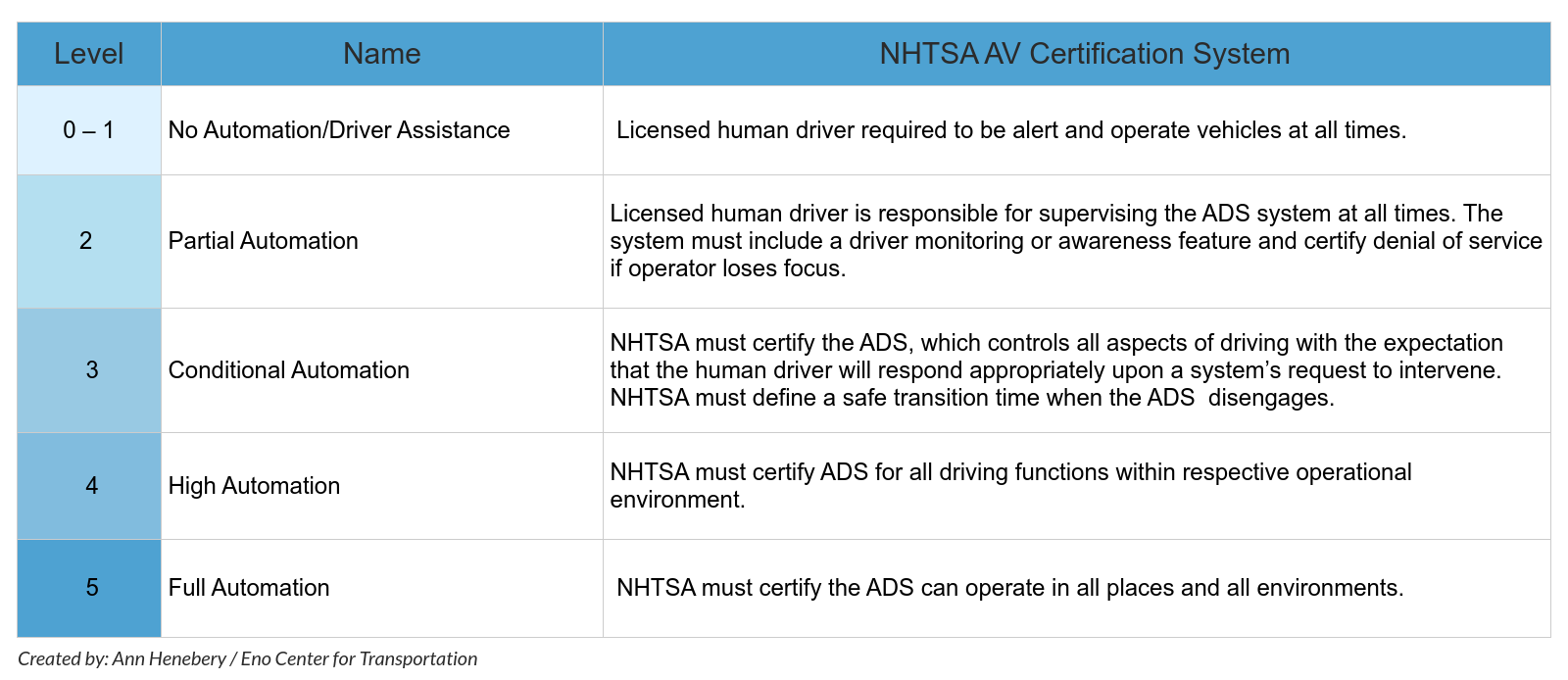May 11, 2017
Companies developing automated vehicle (AV) technology are promising a more efficient and safer transportation system. With developers projecting Level 3 AVs within a few years, this technology could soon be commonplace. But with so many different users sharing the roadway, we need to ensure that the designers are making AVs that are safe for all. Eno’s newest research found that a federal-level safety certification system is good policy, can be done in an efficient way, and needs to happen now.
Recent public opinion polls show that the general public is skeptical of the technology, with over 60 percent responding that they would be concerned about riding in an AV. This is because there is no way for consumers to independently determine if they can trust the software with their lives. In 2016, the National Highway Traffic Safety Administration (NHTSA) released an automated vehicle policy statement, which requests a voluntary safety assessment letter. However, NHTSA has not yet codified anything mandatory that assess the safety of AVs.
States and localities, on the other hand, are passing legislation and executive orders that require AV developers to obtain testing permits, report problems, or in some cases ban AVs in the name of public safety. Even those opposed to increased government regulation find reasons to support a national safety certification system for AVs. Without federal action, a patchwork of state certification processes could easily balloon into a regulatory mess.
Developing safety standards for vehicles has long been under the purview of the federal government. Federal Motor Vehicle Safety Standards (FMVSS) specify the design, performance, and durability requirements for vehicles. These are detailed requirements that make sure that vehicles are safe and will perform well during the life of the vehicle. FMVSS apply across the country and allow for vehicles to cross state boundaries without encountering safety hurdles at borders. For their part, states they have retained the role of managing liability, licensing, and registration for traditional vehicles. Those respective roles of the federal and state governments would not change.
But certifying a software system and its relevant hardware components, instead of a physical product, is something that NHTSA has not done before. This poses several challenges. First, software is much more difficult to prove safe than a product or component, especially when it is designed to operate in a world with an infinite list of unanticipated challenges. Also, inspecting the code and hardware of an AV system could easily reveal proprietary information, undermining the competitive edge that AV developers have spent billions of dollars to secure. Finally, an AV certification process would need to move as quickly as the technology develops, and has to work when software is constantly being updated and modified.
Although the challenges above will be difficult for Congress and NHTSA to navigate, stakeholders can find a system that works. Research in Eno’s Beyond Speculation AV policy framework outlines a certification process that would assign certifications to AVs based on their “level of automation”, regardless of whether the vehicle is individually owned or part of an AV fleet. A carefully designed certification system can address the challenges above while still demonstrating to the public that AVs are safe.
The system proposed in the paper requires a certification for Level 3 and higher. To pass a certification test, the AV developer would need to demonstrate that the vehicle is safe for all users in and around the vehicle, including appropriately responding to interactions with emergency vehicles, pedestrians, traffic cops, bicyclists, trucks, motorcyclists, non-automated vehicles, animals, and anything else that can be on the roadway.
Proposed Certification System for Automated Vehicles

Admittedly, it is not yet clear exactly how NHTSA will administer such a certification system, or whether it has the financial resources to do so. But discussions in the industry have already started to tease out what such a certification system would look like. Perhaps it takes the form of a virtual and on-road audit of how the AV addresses complex scenarios, or maybe NHTSA could revoke certification for systems that experience an at-fault collision.
Regardless, it is important not to make the certification prescriptive, where AV developers design to a test. Instead, there needs to be a performance-based evaluation that demonstrates that the vehicles are (for example) 10 times safer than traditional human driving in the conditions in which they are certified to drive.
If the process can develop before AVs are widely deployed on public roadways, then the industry and policymakers can avoid creating a reactionary regulatory environment that would prevent the adoption of this potentially life-saving technology. The good news is that the technology is still in testing phases, and still a few years away from commercial deployment.
Maintaining America’s leadership in the development of automated vehicle technology is critical, and now is the time to develop a federal AV certification system.
Read Eno’s new research report Beyond Speculation: Automated Vehicles and Public Policy.




